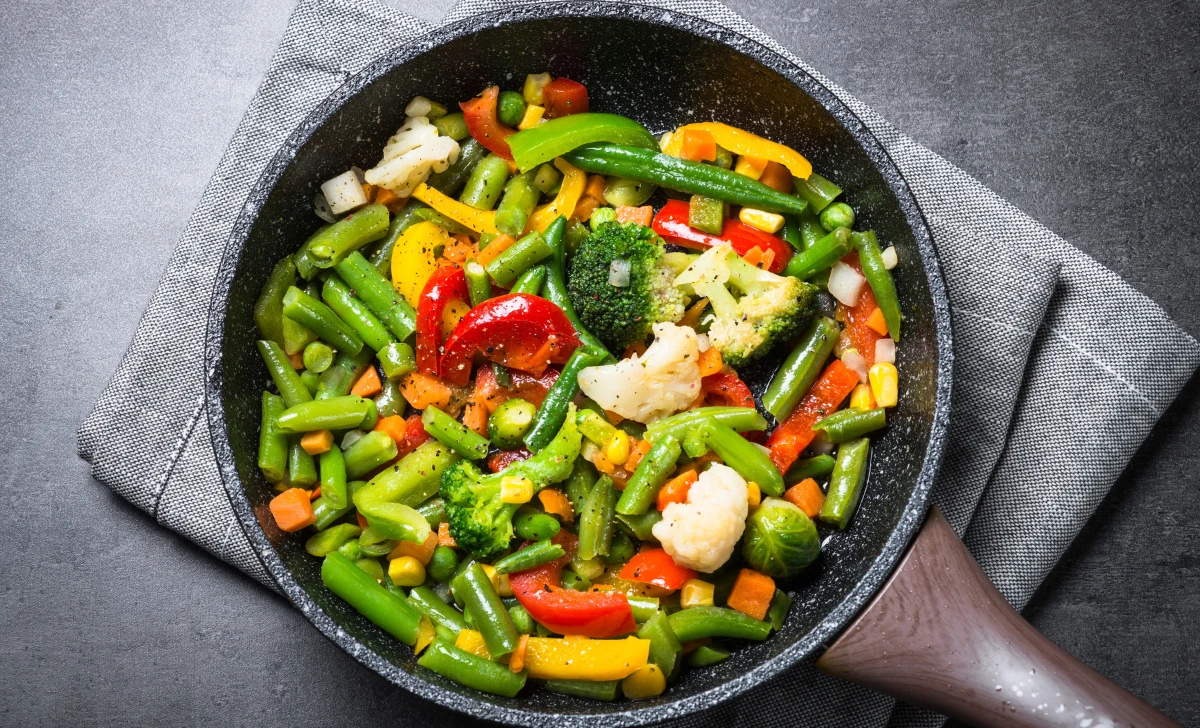Stir fry vegetables are a delightful and healthy way to enjoy a delicious and colorful meal. This cooking technique originated in Asia and has become increasingly popular around the world due to its simplicity and versatility. In this article, we will explore the art of stir fry, its history, the benefits of incorporating more vegetables into your diet, essential ingredients, the cooking process, and some exciting variations to try. Whether you’re a seasoned cook or a beginner, you’ll find plenty of useful tips and ideas to create mouthwatering stir fry dishes.
[ez-toc]
History
Stir fry is a cooking technique that traces its roots back to ancient China. The history of stir fry can be dated back to over 2,000 years ago during the Han Dynasty. The method was initially developed as a means to quickly prepare and cook food in a time-efficient manner.
In ancient China, the stir fry technique was popular among home cooks and professional chefs alike due to its simplicity and ability to retain the natural flavors and nutritional value of the ingredients. The term “chao” in Chinese means to stir-fry, and it involves tossing and stirring ingredients in a hot wok or skillet over intense heat.
The wok, a versatile and distinctive cooking vessel, played a significant role in the development of stir fry. Its concave shape and high, sloping sides allowed for even heat distribution, making it ideal for quick and efficient cooking. The Chinese quickly discovered that the wok’s design enabled them to cook ingredients rapidly and uniformly, making it an essential tool in their culinary traditions.
As trade and cultural exchanges expanded across Asia, the stir fry technique spread to neighboring countries like Japan, Korea, Thailand, and Vietnam. Each region infused their unique flavors and ingredients into the stir fry method, resulting in a diverse array of stir fry dishes.
In the modern era, stir fry gained global popularity, thanks to the widespread appreciation for Asian cuisine. People all around the world now enjoy various stir fry vegetable dishes as part of their regular meals. With its emphasis on fresh and colorful ingredients, stir fry has also become a go-to option for those seeking a healthier and more balanced diet.
Today, stir fry vegetables continue to be a beloved choice for cooks of all skill levels. Its rich history, simplicity, and ability to incorporate an array of flavors have made it a timeless cooking method that continues to be cherished by food enthusiasts worldwide.
Time
| Step | Time (Approx.) |
|---|---|
| Preparing and Cutting the Vegetables | 15 minutes |
| Sauce Selection for Stir Fry | 5 minutes |
| The Cooking Process: Stir Frying Vegetables | 10 minutes |
| Serving and Pairing Stir Fry Vegetables | 5 minutes |
Please note that the times mentioned above are approximate and may vary depending on individual cooking skills and the specific ingredients used. Additionally, the preparation time can be reduced if you have pre-cut vegetables or pre-made sauces readily available.
Ingredients
| Ingredients | Quantity for 2-Person Serving |
|---|---|
| Mixed Vegetables (e.g., bell peppers, broccoli, carrots, snap peas, mushrooms) | 2 cups |
| Cooking Oil (e.g., vegetable oil, sesame oil) | 2 tablespoons |
| Garlic (minced) | 2 cloves |
| Ginger (finely chopped) | 1 tablespoon |
| Soy Sauce (low-sodium recommended) | 2 tablespoons |
| Oyster Sauce | 1 tablespoon |
| Sesame Seeds (optional, for garnish) | 1 teaspoon |
| Green Onions (chopped, for garnish) | 2 tablespoons |
| Salt and Pepper (to taste) | As needed |
These ingredients are for a basic stir fry vegetable recipe and can be customized based on personal preferences and dietary restrictions. Feel free to add other vegetables, proteins, or spices to suit your taste. Enjoy your delicious stir fry vegetable dish!
Directions
Step 1: Prepare the Vegetables
- Wash the mixed vegetables thoroughly under cold running water.
- Chop the vegetables into uniform-sized pieces to ensure even cooking.
- If using broccoli, separate them into florets, and peel and slice carrots into thin strips.
- Slice bell peppers and mushrooms into thin strips, and remove the ends from snap peas.
Step 2: Prepare the Sauce
- In a small bowl, combine soy sauce and oyster sauce.
- Mix well until the sauces are evenly blended.
- Set the sauce aside for later use.
Step 3: Heat the Wok
- Place a wok or a large skillet on medium-high heat.
- Add cooking oil to the wok and let it heat for a minute.
- Tilt the wok to coat its sides with oil.
Step 4: Add Garlic and Ginger
- Add minced garlic and chopped ginger to the heated wok.
- Stir-fry for about 30 seconds or until they release a fragrant aroma.
Step 5: Stir Fry the Vegetables
- Add the chopped vegetables to the wok.
- Stir-fry them quickly and continuously to evenly cook.
- You can use a spatula or chopsticks to keep the vegetables moving.
- Stir-fry for approximately 3-5 minutes or until the vegetables are tender-crisp.
Step 6: Add the Sauce
- Pour the prepared sauce over the stir-fried vegetables.
- Toss the vegetables in the sauce until they are coated evenly.
- Continue stir-frying for another 1-2 minutes to allow the flavors to meld.
Step 7: Season and Garnish
- Taste the stir fry and add salt and pepper as needed.
- Sprinkle sesame seeds over the vegetables if desired.
- Garnish with chopped green onions for added freshness.
Step 8: Serve
- Transfer the stir-fried vegetables to a serving dish.
- Serve hot alongside steamed rice or noodles for a complete and satisfying meal.
Enjoy your delicious and nutritious stir fry vegetable dish, perfect for a quick weeknight dinner or a delightful lunch option!
Equipment Required
Nutrition Information
| Nutrition Information | Per 2-Person Serving |
|---|---|
| Serving Size | 1 plate |
| Calories | 250 kcal |
| Total Fat | 12g |
| Saturated Fat | 2g |
| Trans Fat | 0g |
| Cholesterol | 0mg |
| Sodium | 800mg |
| Total Carbohydrates | 30g |
| Dietary Fiber | 8g |
| Sugars | 10g |
| Protein | 8g |
| Vitamin D | 0mcg |
| Calcium | 80mg |
| Iron | 2mg |
| Potassium | 500mg |
Please note that the nutrition information provided is approximate and can vary based on the specific ingredients used and their respective quantities. Additionally, the values may change if you make any modifications or substitutions to the original recipe. Always refer to the nutrition labels on the actual ingredients used for the most accurate information.
Tips
- Preparation is Key: Ensure all the vegetables are washed, chopped, and ready before starting the cooking process. Stir fry requires quick cooking, so having everything prepared beforehand will make the process smoother.
- Uniform Cutting: Cut the vegetables into similar sizes to ensure they cook evenly and at the same rate. This will prevent some pieces from being overcooked while others remain undercooked.
- High Heat is Essential: Use a high heat setting for your stove or wok. The intense heat will help retain the vibrant colors and crispness of the vegetables.
- Work in Batches: If you have a large quantity of vegetables, it’s best to cook them in batches. Overcrowding the wok can lead to steaming rather than stir frying, resulting in soggy vegetables.
- Don’t Overcook: Keep a close eye on the vegetables while stir frying. Overcooking can lead to mushy vegetables, which will diminish their flavor and texture.
- Add the Sauce Gradually: When adding the sauce, start with a little and adjust according to your taste preferences. You can always add more, but you can’t take it back once it’s in the wok.
- Customize the Sauce: Experiment with different sauces and seasonings to suit your taste. You can try adding chili sauce for a spicy kick or honey for a touch of sweetness.
- Protein Additions: Feel free to add protein sources like tofu, chicken, beef, or shrimp to make it a complete meal. Cook the protein separately and add it to the stir fry towards the end.
- Nutty Crunch: For added texture, toss in some toasted nuts like cashews or peanuts during the last few minutes of stir frying.
- Go Beyond Rice: Serve the stir fry with quinoa, noodles, or even on a bed of leafy greens for a lighter option.
Pros & Cons
| Pros | Cons |
|---|---|
| ✅ Quick and Easy to Prepare | ❌ High Sodium Content |
| ✅ Nutritious and Healthy Option | ❌ Risk of Overcooking Vegetables |
| ✅ Versatile and Customizable | ❌ Requires Frequent Stirring |
| ✅ Bursting with Flavor | ❌ Potential for Overcrowding |
| ✅ Colorful and Appealing | ❌ May Require Specialized Cookware |
Conclusion
In conclusion, stir fry vegetables are a delightful and nutritious addition to any mealtime repertoire. This quick and easy cooking technique offers a burst of flavor, vibrant colors, and a healthy dose of essential nutrients. With its rich history originating from ancient China and its global popularity today, stir fry vegetables have stood the test of time as a versatile and beloved dish.
The beauty of stir fry lies in its adaptability, allowing you to customize the recipe according to your taste preferences and dietary needs. From the selection of vegetables and sauces to the incorporation of protein options, the possibilities are endless. Whether you prefer a savory umami flavor, a touch of sweetness, or a hint of spiciness, stir fry can cater to your culinary desires.
Not only is stir fry vegetables a visually appealing and appetizing dish, but it is also a great way to incorporate more vegetables into your diet, promoting a healthier lifestyle. By choosing fresh and colorful ingredients, you can ensure that your plate is filled with a wide array of vitamins, minerals, and dietary fiber.
So, why not embark on a culinary adventure and try your hand at preparing this delectable stir fry vegetable recipe? With the provided tips and tricks, you are well-equipped to create a mouthwatering dish that suits your personal tastes and preferences. Whether you’re a seasoned cook or a novice in the kitchen, stir fry vegetables offer an easy, enjoyable, and rewarding cooking experience.
Take a leap into the world of stir fry and savor the delightful flavors, textures, and aromas that this dish has to offer. Don’t hesitate to experiment with various ingredients and seasoning to find the perfect combination that tantalizes your taste buds. A plate of vibrant and nutritious stir fry vegetables awaits you – a culinary journey that promises to be both satisfying and healthful.
So, gather your ingredients, heat up that wok, and get ready to indulge in a delightful stir fry vegetable adventure. Your taste buds and your body will thank you for this scrumptious and wholesome dining experience. Happy cooking and bon appétit!
Facts
- 1. 🌐 Global Fusion 🍜
- Stir fry vegetables, originating in ancient China, have experienced a journey of culinary fusion worldwide. As the cooking technique spread to neighboring Asian countries, each region added its unique twist with locally available ingredients, creating an incredible variety of flavors and textures in stir fry dishes.
- 2. 🥢 Wok: The Secret Weapon 🍳
- The wok, a versatile and iconic cooking vessel, has played a pivotal role in the success of stir fry. Its design allows for quick and even cooking, making it the perfect tool to achieve the characteristic smoky, caramelized flavors that stir fry vegetables are renowned for.
- 3. 🌈 Colorful Palate 🎨
- Stir fry vegetables are not only a treat for the taste buds but also a feast for the eyes. The vibrant hues of the bell peppers, broccoli, carrots, and snap peas make for an appetizing and visually appealing dish that entices even the pickiest eaters.
- 4. 🥡 Takeout Favorite 🚴
- Stir fry vegetables have become a beloved choice in takeout and delivery menus worldwide. Its quick preparation time and healthful appeal make it a popular option for those seeking a balanced meal on the go. Plus, who can resist the joy of savoring tasty stir fry from the comfort of their own homes?
- 5. 🍲 From Side Dish to Main Course 🍛
- While traditionally served as a side dish in Chinese cuisine, stir fry vegetables have evolved to become a star player on the dinner table. With the addition of protein options like tofu, chicken, or shrimp, this humble vegetable dish transforms into a satisfying and wholesome main course.
FAQ’s
Can I use frozen vegetables for stir fry?
Yes, you can use frozen vegetables for stir fry. However, fresh vegetables generally have better texture and flavor. If using frozen vegetables, thaw them first and pat them dry to avoid excess moisture during cooking.
Is stir fry vegetables a vegan-friendly dish?
Yes, stir fry vegetables can be easily adapted to a vegan-friendly recipe. Simply use plant-based sauces and avoid animal-based proteins like meat or seafood.
Can I substitute soy sauce with a gluten-free alternative?
Absolutely! If you have gluten restrictions, you can replace soy sauce with gluten-free tamari or coconut aminos, ensuring the dish remains delicious and safe for gluten-sensitive individuals.
How do I prevent my vegetables from becoming too soggy?
To prevent soggy vegetables, make sure not to overcrowd the wok while stir-frying. Work in batches if needed, and use high heat for quick cooking. This way, the vegetables retain their crispness and texture.
Can I add meat or seafood to the stir fry vegetables?
Absolutely! Stir fry vegetables are versatile and can be paired with various proteins like chicken, beef, shrimp, or tofu. Cook the proteins separately and add them to the stir fry during the final minutes of cooking.
What other seasoning options can I use to enhance the flavor?
You can experiment with different seasonings like garlic powder, Chinese five-spice, or red pepper flakes to add depth and complexity to the dish.
How long can I store leftover stir fry vegetables?
Leftover stir fry vegetables can be refrigerated in an airtight container for up to 3 days. Reheat them in a skillet over medium heat or in the microwave before serving.
Can I prepare stir fry vegetables ahead of time for meal prepping?
Yes, stir fry vegetables can be prepped ahead of time by washing, chopping, and storing the vegetables in the refrigerator. When ready to cook, simply proceed with the stir fry process.
Can I use other cooking oils instead of vegetable oil?
Yes, you can use oils like peanut oil, canola oil, or sesame oil to add unique flavors to your stir fry vegetables.
What is the best way to reheat leftover stir fry vegetables?
To reheat leftover stir fry, gently warm it in a skillet with a splash of water or broth to prevent drying out. Stir continuously until heated through and serve immediately.












Leave a Review